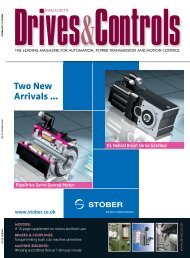New Danfoss VLT® Decentral Drive E cient, reliable and powerful
New Danfoss VLT® Decentral Drive E cient, reliable and powerful
New Danfoss VLT® Decentral Drive E cient, reliable and powerful
You also want an ePaper? Increase the reach of your titles
YUMPU automatically turns print PDFs into web optimized ePapers that Google loves.
GAMBICA VIEWPOINT<br />
Taking the open road<br />
In the third of Gambica’s exclusive columns for<br />
<strong>Drive</strong>s & Controls, the organisation looks at how open<br />
communications are giving manufacturers the flexibility to<br />
deal with today’s challenges.<br />
Businesses across a broad spectrum of industries are looking to<br />
deploy integrated, cost-effective automation solutions that link the<br />
plant floor to the rest of the enterprise. As well as providing control,<br />
this trend is being driven by the need to access plant floor process<br />
<strong>and</strong> equipment remotely for process status <strong>and</strong> diagnosis reports,<br />
asset management, <strong>and</strong> quality control – <strong>and</strong> to improve overall<br />
operational efficiency.<br />
Added to this is the need to provide clear migration paths from<br />
installed legacy systems, while at the same time ensuring futureproof<br />
architectures that support the broadest range of best-in-class<br />
products with easy interoperability to solve dem<strong>and</strong>ing control<br />
applications <strong>and</strong>, most importantly, are not restricted to proprietary<br />
or vendor-specific solutions.<br />
As we approach the end of the first decade of the new<br />
millennium, the explosion of the Internet <strong>and</strong> the development of<br />
Internet Protocol (IP) based services in our daily lives, as well as the<br />
arrival of a new generation of decision-makers familiar with these<br />
high-tech solutions, has resulted in a growing acceptance <strong>and</strong><br />
expectation that these new technologies will be applied to enhance<br />
<strong>and</strong> improve industrial <strong>and</strong> process applications.<br />
As a result, the combination of open Ethernet technology <strong>and</strong><br />
Web services, along with other open industry st<strong>and</strong>ards for software<br />
<strong>and</strong> device integration – such as FDT/DTM technology – is changing<br />
the face of industrial <strong>and</strong> process control.<br />
FDT (Field Device Tool) technology st<strong>and</strong>ardises the<br />
communication <strong>and</strong> configuration interface between field devices<br />
<strong>and</strong> host systems. It provides a common environment for accessing<br />
a device’s features, so they can be configured, operated, <strong>and</strong><br />
maintained via a st<strong>and</strong>ardised user interface, regardless of the<br />
device type or supplier, or the communication protocol.<br />
FDT closes the fieldbus gap by providing a st<strong>and</strong>ard way for<br />
device vendors to create user interfaces for advanced device<br />
management. It allows device manufacturers to install a single DTM<br />
(Device Type Manager) driver to use a device with multiple<br />
Windows-based software products, such as asset management, PLC<br />
programming, <strong>and</strong> device configuration <strong>and</strong> parameterisation<br />
programs. FDT provides a workspace environment for the DTMs to<br />
be configured, <strong>and</strong> a method for communicating between PCs <strong>and</strong><br />
field devices.<br />
In the not-too-distant past – <strong>and</strong>, in many cases, still today – the<br />
way to integrate control equipment with enterprise systems would<br />
involve a combination of multiple proprietary technologies. Control,<br />
I/O <strong>and</strong> device networks would exist separately <strong>and</strong> use different<br />
network <strong>and</strong> fieldbus technologies, while sensor <strong>and</strong> actuator<br />
connections still relied heavily on hard wiring, with its cabling <strong>and</strong><br />
installation costs. To read data from low-level devices required the<br />
data to be “transformed” at each layer – from bits to bytes, bytes to<br />
data, <strong>and</strong> then data to information. This traditional approach puts a<br />
heavy burden on the automation controller <strong>and</strong> on Scada<br />
applications.<br />
Simple, open technology st<strong>and</strong>ards are the best way to foster the<br />
emergence of new, more effective applications. Collaboration with<br />
international st<strong>and</strong>ards organisations, such as the IEC <strong>and</strong> ISO, plus<br />
groups such as the Zigbee Alliance, FDT Group, OPC Foundation<br />
<strong>and</strong> ODVA, are essential for this to happen.<br />
The great advantage of using open st<strong>and</strong>ards – <strong>and</strong>, in particular,<br />
Ethernet-based networks using the Internet Protocol (IP) suite – is<br />
that they are essentially neutral to higher-level protocols. This means<br />
that they can be a part of a platform to connect diverse systems via<br />
modern methods such as service-oriented architectures (SOAs).<br />
Simple, open technology<br />
st<strong>and</strong>ards are the best way<br />
to foster the emergence of new,<br />
more effective applications.<br />
Although normally associated with the business processing<br />
environment, SOAs are fundamental to Microsoft’s .Net framework<br />
<strong>and</strong> provide a unified programming model for rapidly building<br />
service-oriented applications that communicate across the Web <strong>and</strong><br />
the enterprise. Other major software developers, such as IBM, BEA,<br />
Sun, HP, Oracle <strong>and</strong> SAP, are moving in a similar direction.<br />
The challenges faced by today’s manufacturing <strong>and</strong> process<br />
industries have been compounded by the volatile state of the<br />
global economy. In this environment, the dem<strong>and</strong>s on the control<br />
system go beyond functional <strong>and</strong> regulatory performance. It<br />
becomes a tool to not only to manage the plant, but also to reduce<br />
energy consumption, to cut costs <strong>and</strong> emissions, <strong>and</strong> to provide<br />
quick <strong>and</strong> precise information from the field to the enterprise,<br />
supporting both production <strong>and</strong> business decisions.<br />
Today’s challenges require control systems that are not only easy<br />
to engineer <strong>and</strong> maintain, but that also deliver a clear picture about<br />
what is happening in the process, regardless of the application.<br />
Control systems must be flexible enough to be tailored to meet the<br />
needs of all types of process including discrete, batch, continuous<br />
<strong>and</strong> safety (or any combination of these) <strong>and</strong> be capable of<br />
integrating easily with energy management <strong>and</strong> third-party devices.




